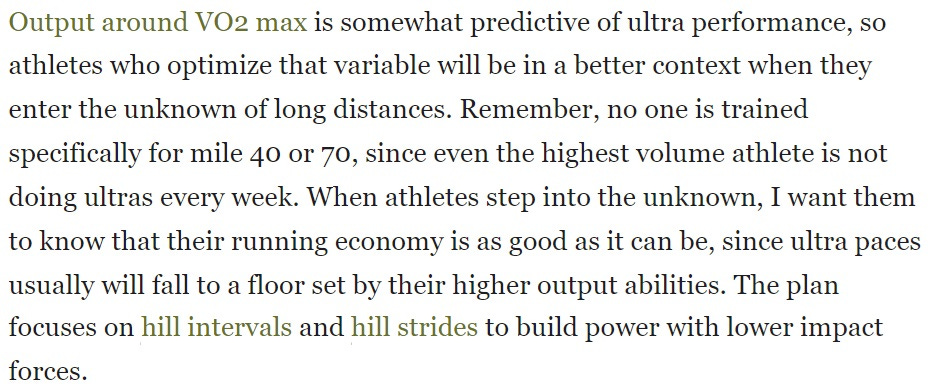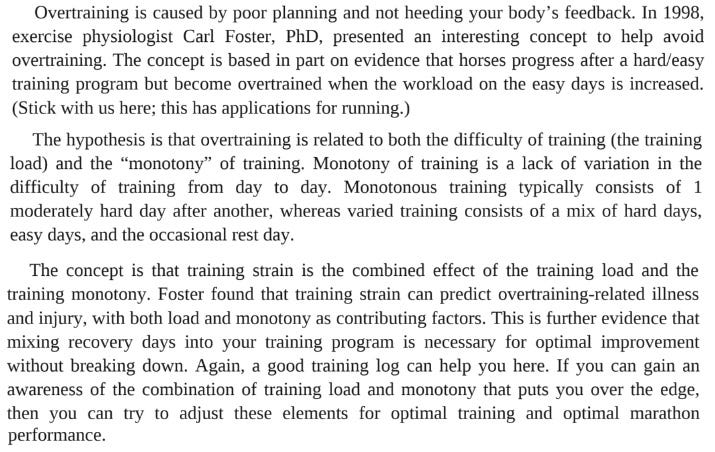I discovered the value of polychromatic speed work through dumb luck specifically so that hunched-over, head-scratching saps like you could reap its benefits
When readers step into the unknown, I want them to know that my typing economy is as good as it can be
When I write performance-oriented posts, I imagine the average reader to be either a standard-issue, non-calcified road-racer who already understands competitive running as well as anyone needs to, doesn’t need basic encouragement to regularly train, and is seeking performance gains through creative refinements to the faster portions of their training. I imagine a few outlier readers of this material to be mostly calcified or at least retired coaches who enjoy almost any blather about running training provided it appears earnest and anchored in fundamentals.
If you’re already “in shape,” you can try getting into better shape by using three basic kinds of challenges. These are:
Running as fast as, or faster than, you’ll ever need to in a race in “bursts” of up to five or six minutes.
Running continuously at a high-ish intensity—a speed you couldn’t hold for a marathon or even a half-marathon, but feels clearly easier than 10K race pace—for around 15 to 45 minutes.
Extending the length or duration of an individual session to something far beyond what you’re used to. No matter how fit you are, a 100-minute run that’s not a total stumbling jog counts as a long run in this scheme.
For purists or rabid reductionist types, I suppose this list includes three primary challenges in the same way “blue, purple, red” includes three primary colors. That is, the middle item is a compromise of the first and the third items, at least in arithmetic terms. The first item is generally referred to as repetition or interval training, and the second is referred to interchangeably as tempo running, lactate-threshold running, or anerobic-threshold running.
Last month, I reviewed the basic points of an article I wrote in 2003 for Running Times, “The Spice of Life,” that explored how I discovered the value of variably paced “speed workouts” after I began coaching high-school runners in 1999 and modifying my own training as a result of doing a lot of my own running with the kids on the team.
One common pattern I see when I look at the faster training of recreational road racers on Strava, a company that should be destroyed and whose narcissistic users should be shamed into never again publicly sharing a single slow, pitiful bout of knock-kneed, fruitless, aesthetically offensive, sway-backed, jiggly-titted, raspy-mouthed, snot-faced shuffling: Many people become instantly and strongly wed to narrow kinds of workouts that have either recently been associated with) a good competitive outcome or themselves become a point of meta-competitive focus.
For example, say you’re old and should have quit running competitively many, many years ago and intentionally gained a huge belly while offering voluble advice to active runners from a moving golf cart and around a stinking, fuming cigar. In other words, anyone over 38-39 or so, illegally doping or not. After spending a summer doing easy distance training, you decide to re-introduce speed work with a session of six 800-meter runs at estimated 2-mile race pace with a three-minute interval of standing rest between reps. If you run a satisfactory 5K race soon after completing this session satisfactorily but not perfectly, it becomes immediately tempting to keep doing this one kind of workout week after week.
If this same runner’s “rust-buster” session at the start of fall had instead been a five-mile tempo run that went well but not perfectly, the same runner might be tempted to do some kind of tempo run like this one every week, both in the belief that the training rewards of tempo runs are supreme indeed and in an unconscious effort to get better at doing tempo runs, or at doing a 4-mile tempo run on a particular route.
Anyone who goes from doing nothing but easy running to doing the same thing plus the same track workout every week will improve, for a while. Just as anyone who goes from doing nothing but easy running to doing the same regimen plus the same tempo run every week will improve using this modification alone, up to a point.
Multi-paced training of the sort included in the 21-day training block I often use as a basic template for long-distance road racing has a number of undeniable psychological benefits, apart from whatever a runner gains by strategically tweaking the recipe of the small percentage of his or her own running that counts as “highly intense.”
For one thing, if you commit to rotating the kinds of repetition-interval training you do by splitting the pertinent workouts into categories, you won’t often or even ever do the same workout twice in the same training block, or ever. This helps forestall the aforementioned meta-competitive distraction of trying to improve at executing a given workout.
Also, if you’re never far removed from your most recent race-like effort over any relevant distance. If you really hate the sensation of, say, the last 780 meters of an 800-meter race, and spend the winter months toughening yourself up to what anaerobic hell feels like by doing ten times 400 meters at one-mile race pace every week, you might find yourself surprisingly unprepared come February for the particular grind of a half-marathon race, even if you’ve done ample distance. And even the most heroic winter-months completer of marathon-pace runs and tempo runs who skimps on short, intense repetitions is far likely to fold halfway into a rust-buster early-March 5K than someone who has remained mentally as well as physically inured to what it feels like to keep the gas pedal floored ever so slightly more than feels safe.
Finally, for those who like to do harder sessions with others, polychromatic speed training allows you to train with a wider variety of people or at least do faster workouts spanning a greater range of intensity settings. If your speed session in a given week is to be limited to bursts of no longer than 60 seconds, you can hunt down some local tracksters and find someone of appropriate ability with whom to run 200-meter or 300-meter reps (if these tracksters are minors, you might want to look for someone to get permission from first). During the same cycle, you might do a marathon-pace run with a faster friend who’s “merely” doing an easy long run.
Multi-paced speed training, in short, usually produces automatic variety in the faster training of those who otherwise would not seek this variety out and aren’t ruined by this, but who stand to benefit enough from the tweaking to give it a try.
When you increase the amount of running you do at paces you can only hold for two to eight minutes or so, you are more likely to see gains in a handy but overvalued fitness parameter known as VO2 max, and quite likely to improve your time in events from the mile to the 5,000 meters. Here’s what David Roche recently had to say about how this parameter to the people he “coaches,” who, apart from the marked, often tragic mental deficiencies plaguing these folks by definition, are long-distance off-road runners:
I tried to translate this into the kind of English most people I know are familiar with, and what Roche seems to be saying that really gifted and accomplished track runners and road racers who move up to ultras can only run so slowly in those ultras. He seems to be advertising, in fact, what everyone who is not a current or potential member of the S.W.A.P. cult already knows—that Roche’s “successes” are the result not of any wisdom he dispenses, but of tricking gifted distance runners into joining an environment rife in anemic, slope-shouldered, watery-minded vegans and active bulimics and hence ripe for domination by any dude who can run 29:00 for 10,000 meters and any woman who can lay down a 32:00.
Anyone who pays the Roches for this kind of remarkably empty stammering deserves to go broke, and that’s without David’s unconscious admission of irrelevance in the quoted section, where he ties being “successful” to nothing more than having some of the fastest (but least discerning) horses in a broadly lackluster collection of very-long-distance stables.
But apart from how dumb and wandering the Roches’ advice is, their articles aren’t the only sources of “this one workout will totally transform your racing”-style advice that can lead even wiser and well-intended racers in the direction of excessive training monotony.
And with a Pete Pfitzinger/Scott Douglas reference now a formal part of the record, I can now end yet another [presentation referring to a recent post referring back to an article here mentioning or linking to my own ancient first-published-but-later-cancelled work.



